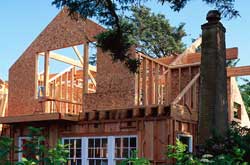America's Five Greenest Flooring Options
See if We Have Top-Rated
Flooring Contractors in Your Area

5. Bamboo
When Better Homes and Gardens', "wanted our test kitchens to look, feel, and perform like the very best kitchen any of us could imagine for our own home," bamboo ended up being the flooring material of choice. High quality bamboo flooring is every bit as hard as oak or maple (which makes it significantly harder than pine), and its look is as unique as it is beautiful. Unlike traditional hardwood trees (some of which need to grow for 50 to 100 years before they are harvested), bamboo can be harvested after only 5 or 6 years, which makes it one of the most eco-friendly flooring options on the market.
4. Cork
While utilized by such big names in architecture as Mies van der Rohe and Frank Lloyd Wright, historically, cork has been far better known as the plug in a wine bottle than as a building material. Today, however, cork flooring is quickly gaining popularity because of its eco-friendliness. Since it is made from the regenerative bark of the cork tree rather than the wood, the tree itself can continue to live and produce more cork after the material for the floor has been harvested. Cork floors are also a hypoallergenic and insulate material.
3. Sustainably Harvested Hardwood
What makes hardwood harvesting "sustainable"? According to the Forest Stewardship Council (FCS), to become certified sustainable "the forests have to be managed to meet the social, economic, ecological, cultural and spiritual needs of present and future generations." We won't go into the "10 principals and 56 criteria" that companies have to comply with to wear the FCS stamp, but rest assured, they are stringent. By purchasing wood products with the FCS label, you are purchasing wood that has been harvested in the most environmentally (and socially) friendly way possible.
Tired of that same old floor? Use this link to
Install New Flooring
2. Reclaimed Lumber
Since it requires the harvesting of no living things and comparatively little manufacturing, "reclaimed wood, which is recovered from old factory buildings, barns, warehouses and other structures that are no longer used" is the greenest option on the market for those looking for a new floor. However, while reclaimed wood is the Denver Green Living Examiner's choice for "most eco-friendly of all wood flooring options" (and ours as well), it is still not the greenest option available for your floors.
1. Keep the Floor You Already Have!
The undeniable winner for greenest flooring option is to make due with what you've already got. Of course, if you're dealing with 20-year-old carpet that is as smelly as it is unattractive, any of the above options will be a fine and eco-friendly investment. However, if you already have flooring that can be resurfaced, refinished or re-stretched, the "green" thing to do (and the less expensive, too) is to leave that flooring in place and spend your money on making it better.
Note: For those who don't have the option of keeping their existing floors, it is a good idea to ask your contractor where they plan on dumping the old flooring. In the case of carpet, you may be able to have it sent to the recycling plant instead of a landfill simply by requesting it!
More Tips & Advice For Your Home
- Related Articles
- Recent Articles

